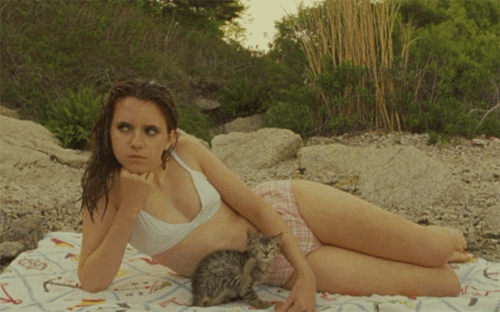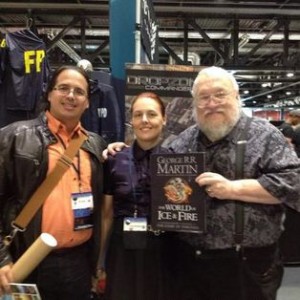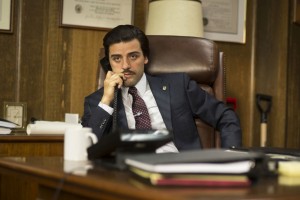Wes Anderson’s Films on Camera Gaze
The issue of gender and patriarchal supremacy has long been a facet of popular culture. Music, television, literature and much more have predominantly been centered on men or reinforced traditional roles of male control and power. Does this bias, however, run so deep that it effects the vary means of producing culture? Laura Mulvey’s essay “Visual Pleasure and Narrative Cinema” argues that so ingrained is male dominance in our culture that it not only infiltrates the content of movies, but even how they are made. She says that both the way consumers watch movies and the way they are filmed perpetuates male control, showing “the way the unconscious of patriarchal society has structured film form” (Mulvey, 393). To examine her claim, it seemed best to look at a director who is both a widely acclaimed Hollywood success, and an independent and stylistically unique artist.
Wes Anderson’s position as a commercially successful director who creates very stylized movies lends him perfectly to this job. To test how widely pervasive this claim actually is (if her claim stretches beyond the blockbuster films that follow commercially successful formulas) one needs to examine films that are popular and widely viewed, but also are stylistically independent enough that they don’t represent the most common movie formulas. This allows for the possibility that Mulvey’s claim is relevant in the biggest movies but also encompasses more independent films. This, in turn, shows that Mulvey’s theory is a broader cultural tendency that affects all Hollywood cinema whether it’s a cookie-cutter blockbuster or a more stylistically individual film.
Wes Anderson uses a very particular and consistent set of elements in his movies. He has a core set of themes and every part of his movies from design to the cast to the style of dialogue and humor is recognizably unique. Most importantly, he employs a unique set of camera shots, which define his movies and are central to how the audience interprets the film. This brings us back to Mulvey’s argument. In “Visual Pleasure and Narrative Cinema” she describes viewing movies by noting:
The extreme contrast between the darkness in the auditorium and the brilliance of the shifting patterns of light and shade on the screen helps to promote the illusion of voyeuristic separation… conditions of screening and narrative conventions give the spectator an illusion of looking in on a private world… the position of the spectators in the cinema is blatantly one of repression of their exhibitionism and projection of the repressed desire on to the performer (Mulvey, 396).
Mulvey is arguing that watching a movie is like peeking onto an unsuspecting world, with the spectator as a sort of peeping Tom and the camera image his or her gaze.
What the camera shows us, then, is supremely important. Mulvey argues a couple of things. The first is that “Traditionally, the woman displayed has functioned on two levels: as erotic object for the characters within the screen story, and as erotic object for the spectator within the auditorium” (Mulvey 398). She is arguing that “women are simultaneously looked at and displayed” in our society, with “their appearance coded for strong visual and erotic impact so that they can be said to connote to-be-looked-at-ness” (Mulvey 397). Her point is that women are portrayed in society as something to be looked at, and this can also be found in film. This is not a particularly unusual claim, but leads into the second one: That the camera is shot from a predominantly male perspective. Her argument is that films contain “liberal use of subjective camera from the point-of-view of the male protagonist” and thus “the audience is absorbed into a voyeuristic situation within the screen scene” (Mulvey, 401). Essentially, the audience becomes conditioned to see the world from a man’s perspective, as it is the view shown via the camera. This is combined with traditional ‘continuity editing’, “the conscious aim being always to eliminate intrusive camera presence and prevent a distancing awareness in the audience… The camera’s look is disavowed in order to create a convincing world in which the spectator’s surrogate can perform with verisimilitude” (Mulvey, 403). The result is that viewers are first conditioned to see via a man’s perspective, gaze upon female’s who are designed to be looked at, and then convinced that this is what reality is through editing that removes the sense that a camera ever existed.
So are these elements apparent in Anderson’s films? The first thing one notices watching them is that nearly all his films have male main characters. Female characters are often relegated to supporting roles and act as love or sexual interests. Even when there are woman with prominent roles, they are in tandem with male leads such as in The Royal Tenenbaums and Moonrise Kingdom, and still experience images of objectification. Margot Tenenbaum is the love interest of multiple men, and is shown as a sexual object multiple times. She is shown both in a montage dedicated to showing her various sexual relationships and naked in a bathtub. Suzy Bishop, from Moonrise Kingdom, is one of the main characters and is the subject of a shot on the beach where she poses nearly naked, as well as one where she is felt up. Both these characters are given much more depth than just as objects to be looked at, but unlike their male leads, they still appear in shots where they are specifically shown as objects of beauty. This type of shot also appears in films without a female lead, such as The Grand Budapest Hotel, where there is again a montage of the elderly female patrons as sexual partners. While their elderly age certainly rejects certain stereotypes of beauty, they are still portrayed as objects for attraction. Most importantly, male characters are not subject to the same portrayal as sexual objects in various scenes. Of the above three movies, only in The Royal Tenenbaums is there a male character portrayed in such a manner, when Eli Cash is shown with his shirt off while visiting Margot.

Beach Scene
In Anderson’s movies, there are more point-of-view shots from male perspectives than female ones. This, however, seems more due to the much larger number of men in his movies (and as mentioned before their tendency to be in leading roles). Anderson himself confirms this, saying in the future “I would love to write a good, big part where the lead character was a woman. I want to see if I could do that well” (Barrett, Wes Anderson Answers). When one examines scenes where males and females interact, prominent female characters get about the same amount of point-of-view shots as male characters. A famous example from The Royal Tenenbaums is the scene where Margot steps off a bus and sees her brother Richie. This is a classic example of the male gaze, with the camera immediately taking up Richie’s view looking at his sister. But importantly, the camera alternates, also showing Margot’s point-of-view. In Moonrise Kingdom Suzy invariably demands a lot of shots from her perspective, and whether it’s on the beach or in the forest or looking down a chimney, she gets just as many as Sam. Even in The Grand Budapest Hotel the female characters with significance have their share of point-of-view shots. Mr. Gustave trades shots with his elderly patron, while Agatha does the same with Zero. A female perspective is shown again and again across these films and presents a single conclusion: Wes Anderson’s movies do not disproportionately favor male point-of-view shots.
This leaves us in a strong position to reject most of Mulvey’s claim, at least in Wes Anderson’s films. It’s true that in his films, women are objectified and used in shots where they are to be looked at by the audience and the characters in the film. This is not the most significant part of Mulvey’s claim however, and in at least the three movies mentioned in this piece, Anderson’s work rejects the other facets. Men don’t get more point-of-view shots proportionally. They do get more, but that is due to their overrepresentation in the films. Anderson seems to see this as a product of what he’s good at, though it’s likely a product of a business that still produces preference towards men, not the actual means. Moreover, Anderson’s unique style is at odds with he typical continuity editing of Hollywood. His “devices also ensure that from the outset the films are not necessarily attempting to construct a cinematic world aimed at verisimilitude, but are signaled as works of fiction, which also helps to foster a degree of intellectual and emotional distance” (Thomas, 9). Anderson’s movies are actually created to be less than realistic, limiting the illusion that any subliminal sexism is a facet of everyday life. This suggests that while Mulvey’s hypothesis may be true of movies of her time, or even certain movies of today, it doesn’t necessarily prevail in the work of Anderson. This in turn suggests that it has not so infiltrated the film industry that every type of movie is affected. Perhaps Wes Anderson is the sole exception, and his unique position makes him unfit to represent movie directors everywhere. It seems more likely that he represents many filmmakers, including both ones who do big movies and others who maintain their indie streak.
This brings us to the final conclusion that Wes Anderson’s films provide evidence to reject Mulvey’s theory. His unique place in the world of film makes him a good case to study due to his position straddling both mainstream Hollywood and more independent filmmaking. His films show that while bias towards women still exists, it mostly stays within portrayal on screen and underrepresentation. It doesn’t reach to the means of creating films, whether it’s filming or editing. This is important as Teresa de Lauretis argues in her book Alice Doesn’t, “cinema works most effectively as an imaging machine, which by producing images also tends to produce woman as image. The stakes for women in the cinema, therefore, are very high and our intervention most important at the theoretical level” (De Lauretis, 37). How women are portrayed in pop culture is important to understand, as only then can society properly go about fixing gender discrimination.
Works Cited
- Barrett, Colleen. “Wes Anderson Answers: Will He Ever Have A Female Protagonist?”Refinery29. Refinery29, 25 Feb. 2014. Web. 18 May 2016.
- Anderson, Wes, Barry Mendel, Scott Rudin, Owen Wilson, Gene Hackman, Anjelica Huston, Ben Stiller, Gwyneth Paltrow, Bill Murray, Danny Glover, Luke Wilson, Alec Baldwin, Robert D. Yeoman, Dylan Tichenor, Mark Mothersbaugh, Karen Patch, and David Wasco. The Royal Tenenbaums. Buena Vista Home Entertainment, 2002.
- Anderson, Wes, Roman Coppola, Bruce Willis, Edward Norton, Bill Murray, Frances McDormand, Jason Schwartzman, Tilda Swinton, Jared Gilman, Kara Hayward, Bob Balaban, Alexandre Desplat, Robert D. Yeoman, and Andrew Weisblum.Moonrise Kingdom. Focus Features, 2012.
- Anderson, Wes, Hugo Guinness, Scott Rudin, Steven Rales, Jeremy Dawson, Molly Cooper, Charlie Woebcken, Christoph Fisser, Henning Molfenter, Ralph Fiennes, F M. Abraham, Mathieu Amalric, Adrien Brody, Willem Dafoe, Jeff Goldblum, Harvey Keitel, Jude Law, Bill Murray, Edward Norton, Saoirse Ronan, Jason Schwartzman, Léa Seydoux, Tilda Swinton, Tom Wilkinson, Owen Wilson, Tony Revolori, Larry Pine, Florian Lukas, Karl Markovics, Neal Huff, Bob Balaban, Fisher Stevens, Wallace Wolodarsky, Waris Ahluwalia, Robert D. Yeoman, Adam Stockhausen, Milena Canonero, Barney Pilling, Alexandre Desplat, and Stefan Zweig. The Grand Budapest Hotel. Fox Searchlight Pictures, 2014.
- Deborah J. Thomas (2012): Framing the ‘melancomic’: character, aesthetics and affect in Wes Anderson’s Rushmore , New Review of Film and Television Studies, 10:1, 97-117
- De Lauretis, Teresa. Alice Doesn’t: Feminism, Semitics, Cinema. Bloomington: Indiana University Press, 1984, 37.






